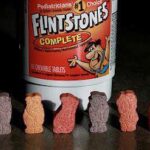 In the 1980s, childhood wasn’t complete without a chalky, fruity tablet shaped like a cartoon caveman. For an entire generation of American kids, Flintstones Vitamins were as routine as brushing your teeth or pouring a bowl of sugary cereal. They were the unofficial breakfast dessert, a daily ritual, and a deeply ingrained part of growing up during that neon-soaked decade. Nearly every child knew the shapes, the flavors, the jingle from the commercials, and the quiet thrill of pulling a Dino instead of a Wilma from the bottle. These weren’t just vitamins—they were an event, a moment, a shared experience across homes, schoolyards, and breakfast tables.
In the 1980s, childhood wasn’t complete without a chalky, fruity tablet shaped like a cartoon caveman. For an entire generation of American kids, Flintstones Vitamins were as routine as brushing your teeth or pouring a bowl of sugary cereal. They were the unofficial breakfast dessert, a daily ritual, and a deeply ingrained part of growing up during that neon-soaked decade. Nearly every child knew the shapes, the flavors, the jingle from the commercials, and the quiet thrill of pulling a Dino instead of a Wilma from the bottle. These weren’t just vitamins—they were an event, a moment, a shared experience across homes, schoolyards, and breakfast tables.
Flintstones Vitamins were introduced in the late 1960s by Miles Laboratories, later acquired by Bayer, but their true cultural apex came in the 1980s. The timing couldn’t have been better. The vitamin market was beginning to expand, and branding was becoming more sophisticated. In an era when parents were starting to worry about balanced nutrition but still feeding their kids Pop-Tarts and Tang, Flintstones Vitamins offered a compromise: a fun, trusted, kid-friendly way to fill the nutritional gaps. The characters came directly from Hanna-Barbera’s animated hit The Flintstones, which, though technically a show from the 1960s, had found new life in reruns and syndication. But by the time many kids were chewing on Fred and Barney’s heads each morning, they weren’t necessarily watching the show at all. The characters had transcended their origins and become mascots of wellness.
Every bottle of Flintstones Vitamins was a colorful promise of strength and health, reinforced by endlessly catchy advertising. The most iconic jingle—“We are Flintstone kids, 10 million strong and growing!”—was burned into the brains of children everywhere, often aired during Saturday morning cartoon blocks and before or after shows like Inspector Gadget or Alvin and the Chipmunks. The commercials showed kids running, jumping, growing taller and stronger, thanks, of course, to their daily dose of prehistoric power. In the minds of millions, that morning tablet wasn’t just something your parents made you take—it was the reason you were fast, healthy, and heroic. In truth, the tablets tasted more like flavored chalk than candy. They came in a variety of fruity flavors and colors, each corresponding with a different character: Fred, Barney, Wilma, Betty, Pebbles, Bamm-Bamm, Dino, and sometimes The Great Gazoo. Kids often had preferences, even superstitions—Dino was cool, Wilma was boring, Barney was the backup if you didn’t get Fred. These tiny tablets had a hierarchy, and part of the joy was choosing your favorite each morning.
Flintstones Vitamins weren’t just a sensory memory—they were also a brilliant example of corporate synergy. Hanna-Barbera licensed the characters to Miles Laboratories, who then injected vitality back into fading cartoon IP through the vitamin aisle. Kids didn’t need to know the show’s plot; they just needed to recognize Fred’s big nose or Dino’s goofy smile. This was the same era that turned Transformers into toys, He-Man into a cereal, and every fast food chain into a fantasy world. Flintstones Vitamins lived at the center of a world where childhood and marketing merged completely. And parents, for their part, welcomed the product. In a time before organic food, gluten concerns, and widespread nutrition literacy, these chewables gave moms and dads peace of mind. They were pediatrician-recommended, easy to administer, and came with a built-in sense of fun. Parents might not have been able to get their kids to eat broccoli, but they could certainly get them to chew on Barney Rubble.
There were concerns, of course. Some formulations included iron, which led to reports of accidental overdose when children mistook the colorful tablets for candy and ate handfuls at once. This prompted the addition of child-proof safety caps and stricter labeling. The irony wasn’t lost on anyone: vitamins meant to help could hurt if they were too appealing. But for most families, those risks were manageable. Bottles were kept high, behind kitchen cabinets, handed out carefully in single doses each morning. The vitamins became almost sacred, doled out like magic beans that made you stronger, smarter, and ready for anything a day in second grade could throw at you.
Nutritionally, Flintstones Vitamins weren’t perfect. They were packed with synthetic versions of vitamins like A, C, D, and B12, and they often included artificial dyes and sweeteners. But compared to the options of the day—those bitter, horse-sized pills designed for adults—Flintstones were a revelation. They made health feel accessible, even exciting, and they did it with characters that were already woven into pop culture. The fact that they weren’t exactly candy, but felt close enough, made them the rare form of medicine that kids didn’t fight against. That alone was revolutionary.
As the 1990s arrived, the original chalky chewables began to evolve. Gummy vitamins entered the market. New flavors and formulations emerged. The characters stayed the same, but the delivery methods became more varied. Today, Flintstones Vitamins are still sold, in both classic and updated forms, though they compete with a much larger field of competitors. Brands now feature Disney princesses, Marvel superheroes, and other modern figures. But none quite capture the legacy or icon status of the Flintstones. For millions of Gen Xers and older Millennials, that old plastic bottle—with its bright label and fruity scent—holds a nostalgic power that no modern gummy can replicate.
What Flintstones Vitamins offered wasn’t just nutrition—it was a sense of belonging. Every kid you knew had them. They were discussed at lunch tables, traded like Pokémon cards, and occasionally snuck as a forbidden second dose when your parents weren’t looking. They were shared, debated, and bragged about. They created an unspoken morning routine that linked suburban kitchens across the country into one giant community of children who, no matter where they were, started their day with the same colorful chewable.
In the end, Flintstones Vitamins were more than just supplements. They were a symbol of a simpler time, when marketing was magical, mornings were ruled by cartoons, and health came in the form of a dinosaur-shaped tablet. For kids of the 1980s, they weren’t just part of growing up—they were the flavor of childhood.
